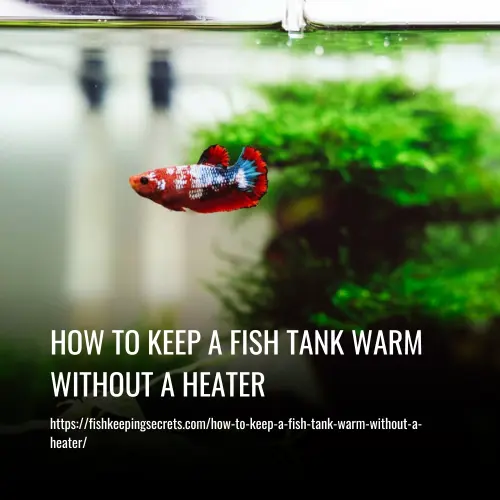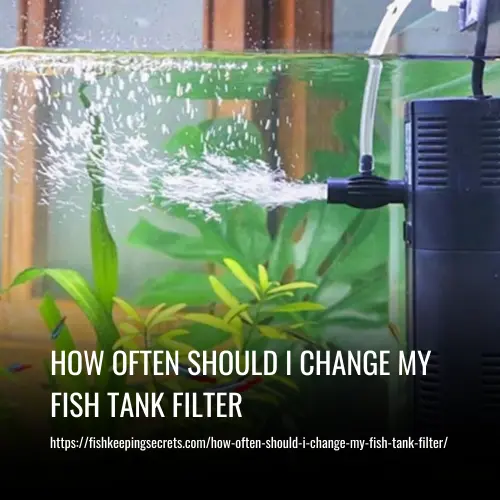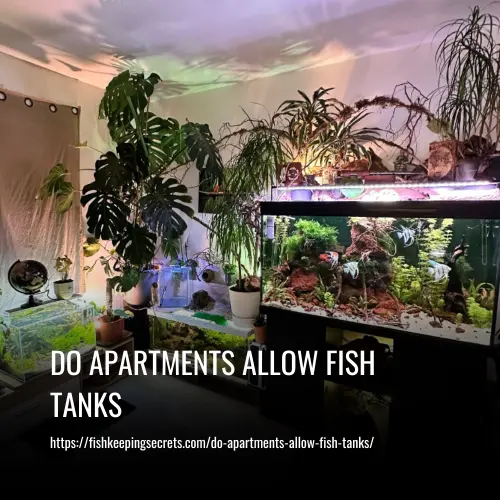How To Keep A Fish Tank Warm Without A Heater
This post contains affiliate links. As an Amazon Associate, we earn from qualifying purchases.
Keeping a fish tank warm without a heater is important for maintaining the health and well-being of your aquatic pets. Whether you’re dealing with a power outage or simply looking for alternative methods to keep the tank warm, there are various strategies you can use to ensure the water temperature stays within the ideal range.
To keep a fish tank warm without a heater, follow these steps:
- 1. Opt for a Smaller Tank
- 2. Choose Coldwater Fish
- 3. Turn Up the Heater in Your House
- 4. Bring Your Aquarium Closer to a Source of Heat
- 5. Warm Water Changes
- 6. Insulating the Glass Walls
- 7. Gradually Increase Water Temperature
- 8. Use a Lid, Hood, or Canopy
- 9. Using Stronger Lights
- 10. Using an Energy-Inefficient Filter
- 11. Use a Heating Mat (Only for small fishbowls)
- 12. Using Blankets or Thick Towels in an Emergency

How To Keep A Fish Tank Warm Without A Heater
There are a few ways to keep your fish tank warm without a heater:
1. Opt for a Smaller Tank
Heat transfer works on the principle that smaller objects are easier to heat. Therefore, if you have a smaller fish tank, it will be easier to keep it warm without a heater. With less water to heat, there will be less heat dissipation, helping to maintain a stable temperature.
2. Choose Coldwater Fish
While it may seem counterintuitive, getting coldwater fish can actually be beneficial in keeping your tank warm without a heater. Coldwater fish are naturally adapted to cooler water temperatures and can tolerate lower temperatures compared to tropical fish. They are hardier and more resilient to changes in temperature, making them suitable for tanks with temperatures ranging from 60-74°F (20-23°C).
3. Turn Up the Heater in Your House
Consider raising the overall temperature in your home, especially if your aquarium is in a room that is cooler than the desired temperature for your fish. This can provide some warmth to your tank without the need for additional heating equipment.
4. Bring Your Aquarium Closer to a Source of Heat
Take advantage of warmer spots in your home and position your tank in those areas. Moving your tank to a higher level in a multistory house can help increase the temperature by a few degrees. Avoid drafty spots, as they can make temperature regulation challenging. Additionally, placing your tank in an area that receives at least six hours of sunlight per day can provide natural warmth to the water.
Keep algae solutions on standby: If you choose to rely on sunlight to warm your tank, be prepared for increased algae growth. Have algae solutions ready to maintain the cleanliness and balance of your aquarium.
5. Warm Water Changes
One way to maintain a specific temperature in your tank is by doing frequent water changes using slightly warmer water. However, you need to raise the temperature slowly, no more than 1° per hour, to avoid harming your fish. Remember to set aside extra water for these changes and mix room-temperature water with boiling water before adding it to the tank.
6. Insulating the Glass Walls
After adjusting the water temperature, you can insulate the glass walls of your tank to prevent heat loss. Although covering them with styrofoam is not aesthetically pleasing, you can use insulation film or foil to achieve the same result. This method will help retain the warmth, but you may still need to perform warm-water changes as a drawback of not having a heater.
7. Gradually Increase Water Temperature
One option is to slowly increase the water temperature by adding a sealed bottle of hot water to your aquarium. Let the bottle float in the tank until the desired temperature is reached. For example, if you want to heat the tank to 80°F, the water inside the floating bottle should be around 120°F. However, keep in mind that this method may cause large swings in water temperature, which can stress out sensitive fish. Use this method with caution and monitor the temperature closely.
8. Use a Lid, Hood, or Canopy
Covering your fish tank with a lid, hood, or canopy can help retain the heat and keep the water warm. This limits the contact between the water’s surface and colder air, preventing heat loss. It’s important to ensure proper ventilation to prevent a decrease in oxygen levels. If you choose this method, make sure to have an air stone or other aeration device running to maintain oxygen levels in the tank.
9. Using Stronger Lights
Using a lighting system with stronger aquarium lights can help generate heat in your tank. This can be especially beneficial if you have plants in your aquarium, as they will also benefit from the increased light and heat. However, make sure to monitor the temperature closely and adjust the lighting duration accordingly to prevent overheating or excessive algae growth.
10. Using an Energy-Inefficient Filter
An energy-inefficient filter can generate more heat due to its motor using extra energy. This can help raise the temperature in your tank, but it’s important to be cautious as the heating effect may vary. Pairing the filter with insulating materials can help retain and distribute heat in the tank. However, be aware that relying solely on an inefficient filter for heating may not provide consistent or precise temperature control.
11. Use a Heating Mat (Only for small fishbowls)
Heating mats are typically used for terrariums or vivariums, but they can be used to raise the water temperature in a small fishbowl. However, it is important to note that this method is not very efficient and may require a barrier between the heating mat and the bottom of the bowl to prevent hot spots and potential glass cracking. While this method is experimental and may not provide consistent heat, it can be a temporary solution in certain situations.
12. Using Blankets or Thick Towels in an Emergency
If you experience a power outage and need a quick solution to keep your fish tank warm, insulating it with blankets or thick towels can help stabilize the temperature and slow down the cooling process. Wrapping the tank’s glass panels with a blanket or towel can provide some insulation and prevent sudden temperature drops that can be harmful to fish, especially those that are not tolerant of cooler water. However, it is crucial to remember that this is not a long-term solution and should only be used as an emergency measure until power is restored.
Remember, it’s important to monitor the temperature regularly and make sure it stays within the acceptable range for your fish.
Why You Need to Keep a Fish Tank Warm Without a Heater
There are several situations where keeping a fish tank warm without a heater becomes necessary or beneficial.
1. Power Outages
During a power outage, a heater cannot function, and the fish tank’s temperature may drop rapidly. Insulating the tank with blankets or towels can help maintain a stable temperature and prevent harm to the fish.
2. Heater Malfunctions/Replacements
If the heater breaks or there is a delay in getting a replacement, finding alternative methods to keep the fish tank warm becomes essential. This ensures that the fish remain in a suitable environment until the heater is fixed or replaced.
3. Housing Tropical Fish
Tropical fish require specific water temperatures to thrive. In situations where a heater is not available or not being used, other measures must be taken to maintain the desired temperature for tropical fish species.
4. Setting up a Quarantine Tank
When setting up a quarantine tank for sick or new fish, it is important to avoid introducing unnecessary items that could contaminate the water. This means not adding a heater unless it is absolutely necessary for the specific fish species or situation.
5. Extreme Winter Temperatures
In regions with extremely cold winters, the risk of the fish tank’s water freezing becomes a concern. Keeping the tank warm without a heater helps prevent the water from freezing and potentially damaging the tank or harming the fish.
6. Cordless Systems
For those seeking a cordless setup or looking to minimize visible cords in their fish tank, inefficient filters or heating mats can serve as alternative methods of providing heat to the tank.
In each of these scenarios, finding ways to maintain a warm and suitable environment for the fish is crucial for their well-being and survival.
How To Keep Fish Tank Warm Without a Heater in an Emergency
In an emergency situation where your fish tank heater is not working, it is crucial to take immediate action to keep the tank warm and ensure the well-being of your fish.
1. Activate Fail-Safe Measures
Check if your tank has any fail-safe measures in place, such as pre-installed backflow tubing and sump shut-offs. Make sure these are active to prevent any further cooling of the tank.
2. Insulate the Filtration System
Wrap blankets, thick towels, or cardboard around the filtration system to insulate it. This will help retain heat and prevent the water from cooling down too quickly.
3. Cover the Tank
Cover the glass panels and the top of the tank to prevent heat from escaping. Use a thick cover or even plastic wrap to create a barrier and maintain the temperature inside the tank.
4. Ensure Adequate Oxygen Supply
Do not block the entire tank’s oxygen supply while insulating it. Make sure there is enough space for fresh air exchange to ensure your fish have enough oxygen to breathe.
5. Minimize Insulation Removal
Avoid removing the temporary insulation layers unless necessary. Every time you remove the insulation, heat will escape, and it will become harder to maintain a warm temperature for your fish.
6. Use a Sticker Thermometer
Place a sticker thermometer on the outer surface of the tank to monitor the water temperature. While not the most accurate, it will give you a general idea if the temperature drops too low and threatens the health of your fish.
7. Slowly Warm Up the Tank
If the emergency situation persists, take action to slowly warm up the tank using the above methods. Gradually increase the temperature to prevent shocking the fish and ensure their well-being.
Remember, these emergency measures are temporary solutions. It is essential to replace or repair the heater as soon as possible to maintain a stable and safe temperature for your fish.
What Is the Ideal Water Temperature in a Fish Tank
The ideal water temperature in a fish tank is typically between 76 and 80 degrees Fahrenheit. Most fish feel comfortable in this temperature range, making it suitable for the majority of aquarium species.
However, it is important to note that exceeding a water temperature of 80 degrees or falling below 76 degrees can be harmful to fish health. Extreme temperatures can stress or even kill fish. Therefore, it is crucial to maintain the water temperature within the appropriate range for the well-being of your aquatic pets.
It is also worth mentioning that there are certain instances where specific fish species may require temperatures outside of the typical range. These exceptions should be carefully researched and addressed to provide the optimal conditions for those particular species.
How Do Extreme Temperature Changes Impact Fish
Extreme temperature changes can have a significant impact on fish, as they are unable to adjust to these changes as easily as humans. Fish are highly vulnerable to thermal stress, which weakens their immune systems and increases their susceptibility to diseases and infections. In severe cases, sudden temperature fluctuations can even lead to the death of fish. Unlike humans, fish have less efficient internal organs for regulating body temperature.
When fish experience thermal stress, they may exhibit signs such as gasping for air at the water’s surface or hiding more frequently than usual. If you observe these behaviors in your fish, it is crucial to take immediate action to stabilize the water temperature and prevent further harm.
Can Fish Survive in Extremely Hot or Cold Water
While some fish can tolerate hot water temperatures for a short period, prolonged exposure can be detrimental to their health. Fish in Death Valley and certain types of tilapia can withstand temperatures up to 113°F, but eventually, their blood protein will coagulate, leading to their demise.
On the other hand, certain fish species have adapted to survive in frigid environments. These fish have an antifreeze-like substance in their blood, allowing them to thrive near the Arctic and Antarctic Circles.
It’s important to note that while some fish can tolerate extreme temperatures to some extent, sudden or prolonged exposure to extremely hot or cold water can still be harmful or even fatal to most fish.
FAQs
The length of time a fish can go without a heated fish tank depends on the type of fish and the temperature of their environment. For example, betta fish can survive without a heater if they’re living in a tropical climate with a year-round temperature of 80°F. In this case, they may not need a heater for a couple of years. However, it’s important to research the specific needs of your fish and provide them with a suitable environment to ensure their health and well-being.
Yes, the size of your aquarium heater is important. It is recommended to calculate the wattage per gallon requirement and choose a heater size that fits your specific needs. Aqueon, a reputable manufacturer of aquarium products, suggests using 5 watts per gallon for tanks up to 55 gallons and 3 watts per gallon for tanks over 60 gallons. If your tank is in a cold room or exposed to low temperatures, you may need a larger heater or even multiple units.
Aquarium heaters function by generating heat and maintaining a specific water temperature in the aquarium. They turn on automatically when the water needs heating and turn off once the desired temperature is reached. This helps to create a comfortable and stable environment for the fish in the aquarium.
Fish are very sensitive to temperature changes, especially aquarium fish that are accustomed to living in warm water with a constant temperature. Even a slight change in water temperature can cause significant stress and weaken their immune system, making them more susceptible to diseases. Cold-water fish like goldfish are more resilient to different temperatures, but prolonged exposure to extreme temperatures can still be harmful to them. It’s important to maintain a stable and appropriate temperature for your fish to keep them healthy and happy.
There are several species of fish that can tolerate extreme waters. Some marine fish in Death Valley can tolerate temperatures up to 113°F, and tilapia fish can swim in hot springs with even higher temperatures. However, these fish can only tolerate the extreme temperatures temporarily before the protein in their blood starts to coagulate. On the other hand, there are fish that can live in icy water, such as those found at the poles. These fish produce a type of antifreeze in their blood, allowing them to survive in temperatures below freezing.
To keep your betta fish warm without a heater, you can try using a heat lamp or placing the fish tank near a heat source like a radiator. It’s also helpful to insulate the tank with blankets or bubble wrap to retain heat. Make sure to regularly monitor the water temperature to ensure a comfortable environment for your betta fish.
To keep a fish tank warm without power, you can insulate the tank by using blankets or foam to trap heat. You can also place the tank near a source of warmth, such as a fireplace or sunlight. Additionally, using warm water during water changes can help maintain the tank’s temperature.
Betta fish, Guppies, White Cloud Mountain Minnows, and Zebra Danios are some examples of tropical fish that can thrive without a heater in aquariums. These fish are known for their ability to adapt to varying water temperatures, so they are suitable for tanks without a heater.
To keep a fish tank warm in a cold room without a heater, you can try insulating the tank with foam or an insulating material to trap heat inside. Placing the tank near a heat source like a radiator or heater can also help raise the temperature. Another option is to use a temperature controller to regulate the tank’s temperature. It’s important to monitor the water temperature regularly to ensure your fish are comfortable and healthy.
To quickly heat up fish tank water, adjust the aquarium heater to your desired temperature. Increase the water temperature gradually to avoid stressing the fish. You can also use a portable heater or a heat lamp as additional heat sources. Make sure the heater is safe for aquatic use and keep a close eye on the water temperature as it heats up.
It is generally safe to use a heat lamp as an alternative to a heater, but there are some things to keep in mind. Be careful not to overheat the water, and make sure to use a high-quality heat lamp that is securely mounted and placed in a safe location.
Some low-cost options for keeping a fish tank warm include insulating the tank with blankets or towels, moving the tank to a warmer area of the room, and using a hot water bottle or hand warmer to warm the water.
Adding plants to a fish tank can help keep it warm because plants release oxygen and absorb carbon dioxide, which can help control the water temperature. Additionally, plants can provide shelter for fish, which can help reduce stress levels and improve overall health.
If the water temperature in your fish tank is too low, your fish may become lethargic, slow-moving or may even die. Other signs of low water temperature include cloudy water, poor water quality, and an increase in bacterial growth.
Conclusion
In conclusion, keeping a fish tank warm without a heater is possible by utilizing a combination of insulation, proper lighting, and regular water maintenance. It’s important to monitor the temperature of the tank closely and make adjustments as needed to ensure a stable and comfortable environment for your fish. Additionally, consider the specific needs of the fish species in your tank and make adjustments accordingly.
Remember that maintaining a consistent and comfortable temperature is crucial for the health and well-being of your aquatic pets. With proper care and attention, you can successfully keep your fish tank warm without a traditional heater.






